The first thing I noticed about this class photo was how stern all the boys look. That isn’t exactly normal for a group of 29 little boys. Then I realized that no one is blinking or fidgeting, which is pretty amazing. Whatever the photographer said to them, it definitely got their attention.
Another striking thing about this cabinet card portrait is how closely cropped it is on all four sides. Only on top is there any space not occupied by people, and there isn’t much of it. I’d love to see a little more of the school building, but that wasn’t a priority at the time.
The portrait was made by M. Pearlmann & Co. of Glasgow and Paisley. On the back, someone wrote a date in pencil: “13.X.00” (October 13, 1900). The printed word JUBILEE is a reference to Queen Victoria’s Diamond Jubilee (60 year reign), celebrated on June 22, 1897.

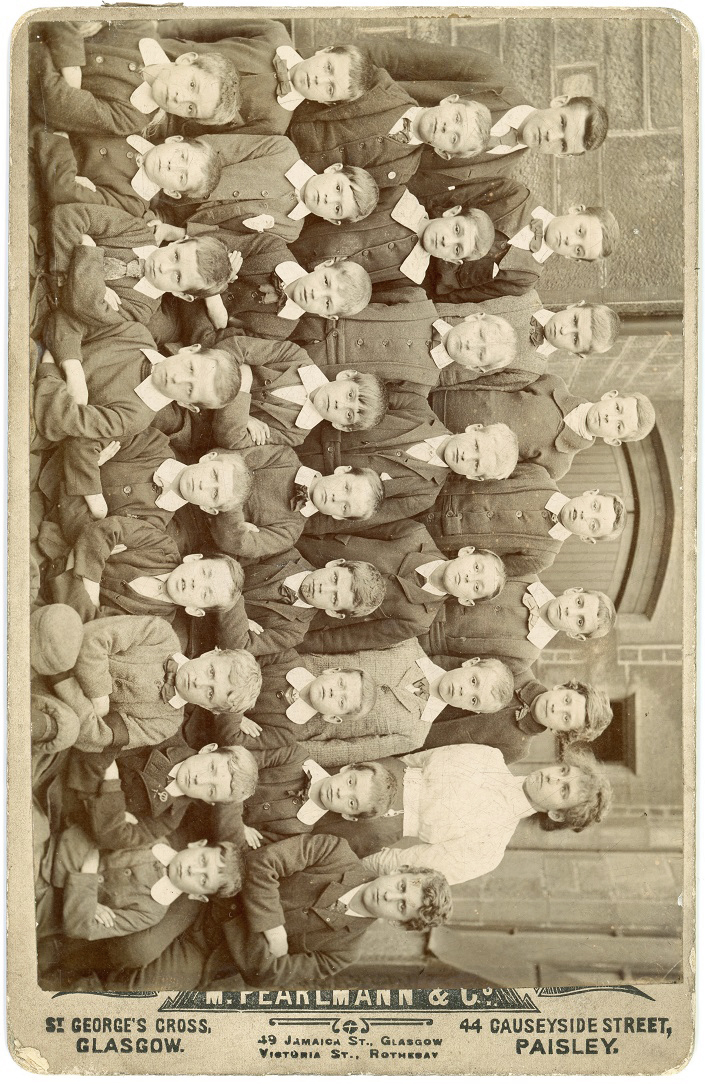
Here’s a question for my readers: do you think the young woman in the photo had a rewarding job or an exhausting one? I suspect most of the boys had a crush on her, which may have made it easier–or harder.
If you’re interested, you can see a few more class photos by M. Pearlmann & Co. here and here.
Update: M. Pearlmann was Moshe (Maurice) Pearlmann. One of his sons, Leonard, also became a photographer: https://www.geni.com/people/Leonard-Pearlman/6000000028150243482

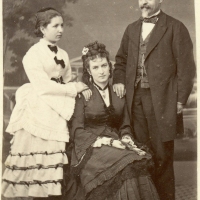
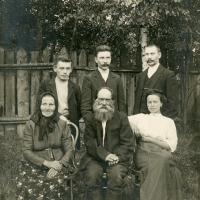
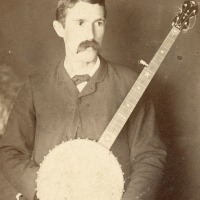
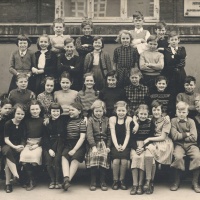
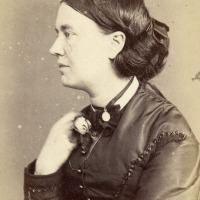
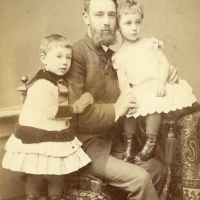
Boys are tough!
I feel like the woman thinks: “What am I doing here? What day is this?”
LikeLiked by 3 people
Haha, maybe you’re right! 😀
LikeLiked by 1 person
I’m with you on this one! Her expression and posture look decidedly resigned.
LikeLiked by 3 people
Nice with old photographers and its history! You are so right, how stern all the boys look.
LikeLiked by 2 people
Thank you! I think they’re just good little actors. 😉
LikeLiked by 2 people
Yes indeed 😀
LikeLiked by 1 person
My favorite is the little kid in the bottom left corner.
LikeLiked by 2 people
He’s so curious! My eye always comes back to the boy at top right, standing just behind the teacher. He looks just like a friend of mine at that age, whose name was Stuart (appropriately Scottish). Stuart was even nerdier than I was, but he had a really cool calculator watch….
LikeLiked by 2 people
The boys in the other two pictures from Pearlman also look very stern. If anything, the younger boys (in the first of the alternate photos) look ever more stern, and that’s weird. I’m sorry to say it, but it looks as if they are a collection of little bullies. But maybe that is just the result of whatever Pearlman said or did to make young children look so serious.
LikeLiked by 1 person
He must have wanted them to concentrate so they wouldn’t blink or look away from the camera. It’s a strange effect, certainly, but maybe he thought it was better than the alternatives.
LikeLiked by 2 people
Almost all of the seated boys have their arms crossed while the standing boys have their hands by their sides. I wonder how many times they were told to – keep your hands to yourself 😂. I’m also intrigued at the way all of the boys look straight into the camera while the young woman looks to the left. It makes me tired just thinking about her efforts. That’s a lot of busy boys! 😊
LikeLiked by 2 people
I’ve often wondered why she’s the only person looking away from the camera. It sets her apart, as though she didn’t feel bound by whatever instructions were given: “I’m not going to scowl at the camera because I’m a woman and I don’t need to conform in that way.” That said, her job must have been difficult. Sorry I made you tired, Suzanne! 😉
LikeLiked by 2 people
It’s kind of funny isn’t it. I like your take on her thoughts! I visited some of those other school portraits. There’s another so much like this – boys all looking forward, one woman looking to the left – mysterious. Well, it also made me grateful. My “boys” with paws and tails make a lot of mischief but there aren’t nearly so many of them. All good Brad! 😉
LikeLiked by 2 people
It’s odd, but I didn’t see that as a boy just behind the teacher. Even at a second look, it seemed like another woman to me, wearing a cape. Maybe it’s the hair. And in the back row, at the far left, I wondered if that was a male teacher. He looks older than even the boys in the back row. There are a couple with sweet, open expressions, but as for the rest? I’d call them the Beastie Boys. They remind me of the bully Scott Farkus in the film “A Christmas Story.” There’s quite a variety of expressions, but not many of them are pleasant. Maybe the crossed arms contribute to the effect.
LikeLiked by 1 person
Yes, I’m sure the fellow in the back at far left is another teacher, as is the fellow with curly hair in front and just to the right of the young lady. I wonder if they were teachers in the sense we think of today, or if their job was more to corral the boys and keep them under control. Early class photos I have from the USA also have more than one teacher or young adult (older teen?) posing with the kids. Here’s one that I’d date to the 1870s or even 1860s: https://tokensofcompanionship.blog/2017/05/15/early-cabinet-card-with-school-group/
LikeLiked by 3 people
Like the classroom aides of today?
LikeLike
Yes, I’d think so. But teachers also started very young in the 19th century, often only a year or two older than their oldest students.
LikeLiked by 1 person
Oh, I recognize the schoolboy scowl! I’ve seen it before, on my little brother’s face in a photo of Mrs. Mortimer’s nursery school class–the same glowering brow, the same crossed arms.
LikeLiked by 1 person
It looks like whatever the photographer said to the boys also worked on the teacher. There is not one smile in any of the photo cards. Must have been important to look studious. Must say I enjoy your text almost as much as the pictures. It brings so much more interest to the photos. Look forward to more.
LikeLiked by 2 people
That’s awfully kind of you, thank you! I wonder if there was also a cultural element to the constraint against smiling. My mother has a little Scottish heritage, and she likes to joke about how dour (pronounced “do-er”) the Scots can be, or were historically.
LikeLiked by 1 person
I suspect you are right. I am sure there were cultural norms that were expected to be met. Also, back then, the teacher had some clout, literally.:)
LikeLiked by 1 person
Yes, you’re right, I’m sure discipline was considered necessary to the formation of proper character (*cringe*).
LikeLiked by 1 person
The teacher does look exhausted and resigned. I wonder if the photographer told the boys if they make one move or smile, no recess! 🙂
LikeLiked by 2 people
That would certainly get their attention! I suspect educators had a large arsenal of threats in those days. Recess would have been VERY important. 😉
LikeLiked by 2 people
All of these wonderful little faces, each with his story. So interesting to think about!
LikeLiked by 2 people
That’s so good to hear. I hesitated to share this one, because I guessed not everyone would like it. It’s thought-provoking, though, and it gives us a tiny glimpse into the world of these boys and their young teachers.
LikeLiked by 1 person
Lovely.
Actually at that time across the world, including North America, all photos were generally non-smiling. You can google the reason for this as it is quite interesting. But it was a standard. I find photos tell so much even without a smile. Some like the boy bottom left show curiosity, and I assume his life was comfortable enough to be free to show that. Others seem angry, some afraid, and some just plain tired, worn by life. They were not easy times. I was directed here by Judith Baxter, my friend in New Zealand, with whom I skype a couple of times a week. I live in Waterloo Ontario. I love your blog and look forward to catching up on previous posts. Chris
LikeLiked by 2 people
Thank you for your thoughtful comments, Chris! I’m glad to know about your blog. Living in Vermont, I’m always curious about Canadian perspectives on the world, and particularly on the USA. I also lived briefly in Alaska, which views the Lower 48 with much the same skepticism that Canadians seem to. Judith Baxter is an inspiring blogger, and it’s fun to hear a New Zealand perspective. Her New Year post was great, wasn’t it? (https://growingyoungereachday.wordpress.com/2019/01/04/another-year-begins/) Thanks for following, and I’ll be glad to follow you as well! Brad
LikeLiked by 2 people
How fabulous that you have a photograph from my home! St George’s Cross, the photographer’s main address, is just down the road from where I live. Causeyside Street in Paisley is near my mother’s house. Small world! I thought most photos in those days were unsmiling as they had to keep their faces still for the long exposure. Mind you, even my group photos in the 1960s are very solemn looking!
Thanks for visiting The Glasgow Gallivanter.
LikeLiked by 2 people
Thank you for visiting and commenting, Anabel! It’s certainly true that people didn’t often smile in photos in the 19th century. I do run across smiles occasionally, which make the photos seem very special. You have a terrific blog and I’ll definitely come visit again! Cheers from Vermont, Brad
LikeLiked by 2 people
I think she’s having a rewarding job as their teacher, despite it is all boys. And I also think those days, these expressions on the photo does not really depict their real emotions and personality, so I would think she’s a bubbly warm teacher (in order to survive and enjoy her work). Not easy for young woman to be seen working, so I still would like to think she’s loving her work 🙂 These smile-less style is so like the local people here in Estonia (every moment and almost everyone, even when they are not taking a photo)
LikeLiked by 2 people
Great comments, Zannnie! It’s easy to forget that smiling in photos–or in public in general–is not universal even today. In the West, especially in America, we try to smile in photos because we want to look happy. But not all cultures consider happiness (or the appearance of it) to be of primary importance in a photo. In painted portraits, smiling is rare; usually the goal of the artist is to present the sitter in a way that represents the sitter’s interests and personality.
LikeLiked by 2 people
Those boys mean business! There is no tomfoolery here.
I’m surprised that the photo is cropped so tightly around the boys. It seems unusual for a photo of that period, no?
In response to your question: I like to think the woman in the photo had a rewarding job and that her students admired her. I bet everyone cried at the end of the school year.
LikeLiked by 2 people
I bet there was plenty of tomfoolery when the camera wasn’t pointed at them! The tight cropping does seem unusual, and I suspect the group was posed with that in mind.
I like your positive sentiments regarding the young woman’s job and relationship to the boys. She looks like a gentle sort of person, although it may not be possible to guess that from a photo. I’m sure she could take care of herself just fine.
LikeLiked by 2 people
I have heard it said that you were supposed to be serious for photos back then, if you were smiling it was a bad reflection on you.
LikeLiked by 2 people
Yes, I think that was the general consensus for a long time, at least until cameras became inexpensive and many people started taking their own pictures (around 1900). Before that, people might only sit for a few portrait photos during their entire lives, so they took them seriously.
Thanks for your visit and comment. I enjoyed your Memorial Day post, “Walkway Over the Hudson.”
LikeLiked by 1 person
Thanks! I enjoy old photos. Have you read Jayne Shrimpton’s book Family Photographs and How to Date Them? I used that to help identify people in old family photos dating back to the mid 1800s.
LikeLiked by 2 people
I’m not familiar with the book. It sounds like a good reference. Thanks for the tip!
LikeLiked by 1 person